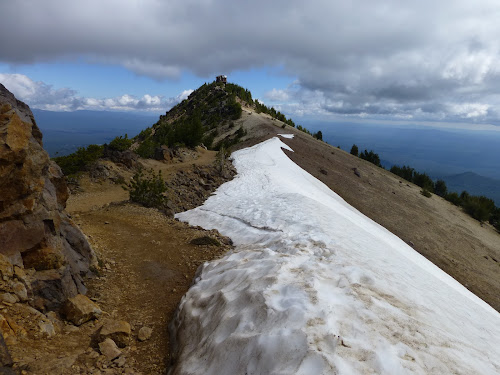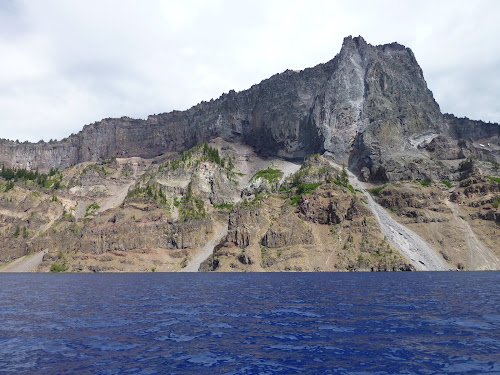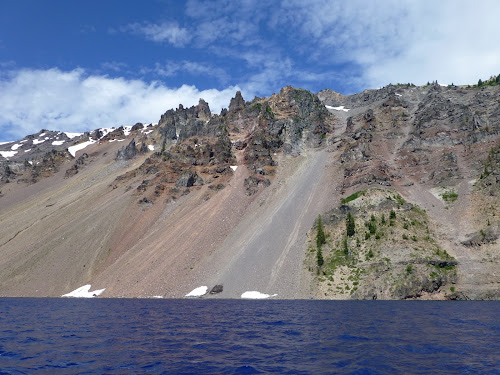What the........?!?
We awake and see an eerie light coming from the crack in the curtains...so we get up and pull back the curtains to find out what's going on outside.
A light fog has formed over the lake, and as the sun rises with its pink and orange early light it has turned the air a brilliant coral color...
There are many trails to hike at Crater Lake, and they can take you in all directions from the Rim Drive. The hikes range from a half mile and little elevation gain to 11 miles and 1,600 feet of elevation gain. We are interested in getting a little exercise, but mostly we want to take in the best view of the lake...so, we head to the highest point it he park, Mount Scott.
Mount Scott sits on the east side of the lake and at 8,929 feet in elevation it is 900 feet higher than Garfield and Watchman Peaks. This trail is a gradual uphill hike from bottom to top, and over the course of 2.5 miles to the top we will gain about 1,250 feet. The mountain is shaped in a semi-circle facing the lake and we can see from the beginning of the trail there there is still a fair amount of snow around...we cross a few patches right away and then begin our ascent...the trail will take us around the back side of this semi-circle then up to the top from the east approach...
Just before the trail heads around the east side of the mountain, we get a view of the lake...
Like other mountains, Mount Scott has a relatively short growing season, and we see flowers blooming alongside the trail...
From up here we can see the whole lake and across the rim to the park beyond. It is actually a beautiful day with the passing clouds and the sun casting shadows on the pumice desert below us...
We know, we have alot of photos of Wizard Island, but not from almost 9,000 feet!
And this has become a pretty frequent sight for us too...Union Peak...which is the 16 mile hike that starts from the lodge...
There are so many great views from up here, so we stop frequently to admire the breadth of Crater Lake...
When we finish our hike it's time for lunch, so we drive a very short distance to the picnic area that sits right at the base of Mount Scott...and we admire the summit we achieved this morning...
In the picnic area there is a sign identifying Whitebark Pine trees...these are special and vanishing trees here at Crater Lake. This type of tree has historically stood around the rim of Crater Lake...some in the park are 500 years old or older, and they are often thick and twisted, showing the signs of just how hard it is to live with the winds and temperatures and heavy snows of this environment. These trees are dying off fast due to a fungus and a beetle...and they are not reproducing fast enough to replace themselves...they don't even produce cones until they are 60 years old! So the park service is working to save these magnificent giants...they have identified some Whitebark Pines elsewhere in the park that are able to resist the fungus, so they are germinating seeds from these hearty trees and planting seedlings by the thousands...and so far the young trees' resistance is showing promise.
It's early afternoon and there is still plenty of time to do a little more exploring, so we decide to drive south along the rim to the Plaikni Falls trail. This trail is relatively new, and only moderately challenging so it is a perfect second hike for the day.
This trail is only 2.2 miles for the round trip, and gains just 100 feet in elevation...and because it is so new it is in great condition.
The falls are not an outflow from Crater Lake, but rather are fed by snow melt...the falls are at the beginning of what becomes Sand Creek, which is the creek at the bottom of the gorge that features the Pinnacles that we saw yesterday!
With two hikes under our belt for the day we return to the lodge for much deserved showers and then to the lobby for some wine and some blogging...
When our dinner reservation time arrives, we head to the Dining Room...and the Crater Lake gods are smiling on us! One of the three view tables has just cleared, so we request it (waiting a few minutes while it is reset) and then slide in to our seats next to the windows! Score!
We enjoy another great dinner, this time watching the colors of the sky and lake as the sun sets...
The Crater Lake Lodge opened in 1915, but was not really that nice...it was known for poor service, low standards of comfort, and a lack of privacy due to its poor construction. The walls were so thin that you could hear everything going on in the neighboring room, and actually see into the next room through cracks in the cardboard wall covering. The lodge always had an "unfinished" feeling due to neglect, and yet it was always popular and filled with guests due to the extraordinary setting of the park.
The lodge doubled the number of guest rooms in the 1920's, and at the same time expanded the plumbing to provide private bathrooms for most guest rooms...but many guest rooms were still left unfinished due to lack of money. The Great Depression and a continued lack of capital caused the lodge to limp along for decades despite constant prodding from the park service to improve the lodge. Then, in 1967, the Park Service acquired the lodge, but was reluctant to renovate or upgrade the lodge despite it's designation on the National Register of Historic Places. They preferred to tear down the lodge, but they encountered strong public opposition so they decided to renovate the lodge.
The Park Service came up with an overall development plan for Rim Village and included in it plans for significant upgrades to the lodge. It was not until the 1991 that construction work on the lodge began...a small portion of the old lodge was saved, but much had to be rebuilt to integrate modern systems and greater stability and safety. The project was completed in the fall of 1994 at a cost of $15 million...on May 20, 1995 it re-opened to the public.


































































